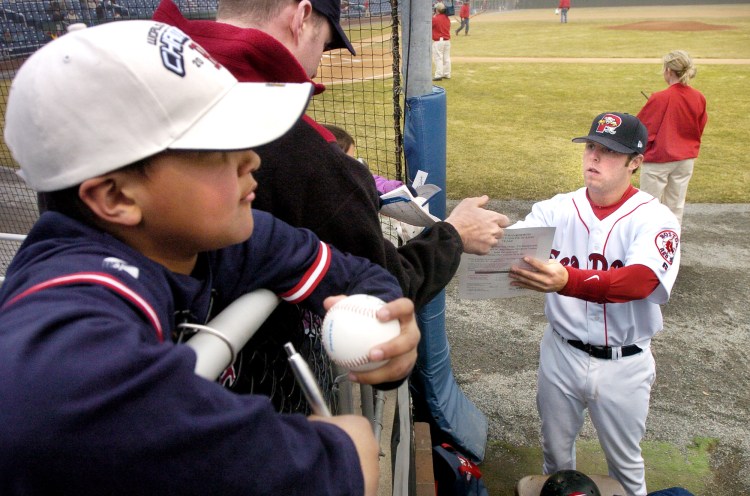There’s been lots of talk about Dustin Pedroia these days, concerning his burdensome knee and questionable future.
But let’s take a look at the past.
Back in 2004, the Red Sox didn’t have a first-round draft pick, losing it as compensation for signing free-agent reliever Keith Foulke. Boston’s first pick in the draft was the 65th overall. Could they find a prospect that others overlooked?
You guessed it. Boston picked Pedroia, a 5-foot-9 shortstop for Arizona State.
Fast forward to the 2019 draft that begins Monday. Boston’s first pick was going to be 33rd overall, but because of new rules concerning the luxury tax, the Red Sox were penalized 10 spots and will draft at No. 43. The team’s 2018 payroll was $239.5 million, $42.5 million over the tax threshold.
That means extra work for scouting coordinator Mike Rikard.
“It created challenges in how you go about scheduling (the scouts),” Rikard said. With an early draft pick, it’s more predictable which players to watch.
“At 43 it’s tougher. We try to invest a lot of time trying to figure out which players would be the best fit for us.”
Rikard said Boston will draft a quality player, and then another (with the 69th overall pick); and hopefully more in rounds 3 through 40.
“I’m very confident we’ll find some impactful players, Rikard said. “The draft does appear to have some depth … I think we’ve uncovered some interesting players deeper, down the line.
“We’re excited. We’re in a good position to get in there Monday and have some success.”
Rikard has been with the Red Sox since 2004, starting as a scouting crosschecker and then scouting coordinator. He helped sign Mookie Betts, Jackie Bradley Jr. and Anthony Rizzo. He took over the amateur scouting department in 2015. and his first draft pick was Andrew Benintendi.
When Rikard joined Boston, it was Theo Epstein’s second season as general manager. Back then, Epstein was looking to quickly restock the farm system with college talent.
“High school players do bring a little more risk,” Rikard said. “College players have a lot more history and performance data.”
Now that the Red Sox have a solid core of young players in the majors, there’s no immediate rush for ready-to-go talent.
Rikard repeats the oft-used phrase that his team will go after the best available player. He said he’s “lining the (draft) board by talent and see how that goes.”
The Red Sox need more depth at catcher, with Blake Swihart traded and no true prospects above low Class A. And Boston, like everyone, could use more pitching, especially arms that develop into starters.
Who might the Red Sox pick? Here are some educated guesses based on various scouting reports, prospect rankings and past Red Sox history:
Reach pick: High school outfielder Maurice Hampton out of Tennessee. An All-American in football and baseball, he plans to play both sports at Louisiana State. Loads of potential. He likely will be drafted before 43rd or, if he drops down, may be difficult to sign.
The following players are projected to go in the second or third round.
College pitchers: Red Sox president Dave Dombrowski likes power arms and Matt Canterino (Rice), Isaiah Campbell (Arkansas) and Drey Jameson (Ball State) can all bring it.
Looking for a left-hander? Ethan Small of Mississippi State may be underappreciated. He had Tommy John surgery in 2017 but appears be a primetime find.
A sleeper is right-hander Ricky DeVito of Seton Hall. DeVito was hurt early in the season, which may make him available in later rounds.
High school pitchers: Left-hander Blake Walston has a commitment to North Carolina State. Not polished but a lot of potential. Trivia: He’s from New Hanover (N.C.) High, the same school that produced Trot Nixon.
Right-hander Jason Wolf would be intriguing if he dropped to Boston’s reach. Wolf, who has a commitment to Texas A&M, features a plus fastball and plus curveball.
College position players: Florida shortstop Brady McConnell has the athletic versatility and advanced bat Boston would love.
If Boston is looking for catchers, Korey Lee (California) and Cooper Johnson (Mississippi) may be among the best available.
The Southeastern Conference is loaded with outfield prospects, so Boston might look there, or at Will Robertson of Creighton, who could go in the second or third rounds.
High school position players: The Red Sox went with high school sluggers in the first two rounds last year. They could add a third with third baseman Rece Hinds, who has a commitment to Louisiana State.
Boston seems to always grab a high school player from Georgia. This year it could be shortstop Nasim Nunez, reportedly a fielding wizard but with a light bat.
The first two rounds of the draft are Monday, with rounds 3-10 on Tuesday and 11-40 on Wednesday.
Send questions/comments to the editors.




Success. Please wait for the page to reload. If the page does not reload within 5 seconds, please refresh the page.
Enter your email and password to access comments.
Hi, to comment on stories you must . This profile is in addition to your subscription and website login.
Already have a commenting profile? .
Invalid username/password.
Please check your email to confirm and complete your registration.
Only subscribers are eligible to post comments. Please subscribe or login first for digital access. Here’s why.
Use the form below to reset your password. When you've submitted your account email, we will send an email with a reset code.